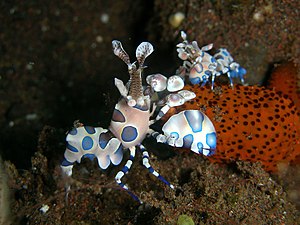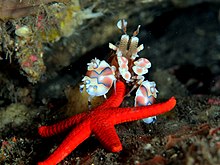Harlequin shrimp
| Harlequin shrimp | ||||||||||||
|---|---|---|---|---|---|---|---|---|---|---|---|---|

Hymenocera picta , blue color morphs |
||||||||||||
| Systematics | ||||||||||||
|
||||||||||||
| Scientific name of the genus | ||||||||||||
| Hymenocera | ||||||||||||
| Latreille , 1819 | ||||||||||||
| Scientific name of the species | ||||||||||||
| Hymenocera picta | ||||||||||||
| Dana , 1852 |
The harlequin shrimp , scientific name Hymenocera picta , is a marine (marine) shrimp species found in the Indian and Pacific Oceans. Today, contrary to earlier theories, it is the only representative of the, thus monotypical , genus Hymenocera . Due to its striking coloring, the species is a very sought-after invertebrate aquarium animal, for which aquarists pay high prices. Due to their specialized diet - the crabs feed exclusively on starfish - breeding of the species in the aquarium is very difficult.
description
Harlequin shrimp reach a body length of about two to five centimeters. The basic color of the animals is whitish with a very conspicuous pattern of brightly colored spots and therefore unmistakable. These can be either red with a dark border (rarely brownish red) or blue (rarely brown). Both color morphs used to be considered two different species, until later both forms were observed next to each other in the same habitat. Today it is assumed that the color depends on the environmental conditions or the food.
The most important feature for determining the species is the widening and leaf-like reshaping of the second antenna whip of the first antenna pair, whereby all whiplash members are fused together. The large claws ( Chela , on the second pair of peraeopods ) and the third maxillipedas are also widened like leaves. The shape of the mandibles , which lacks the incisor, the cutting tooth-like projection on the chewing bar, is also considered to be taxonomically important .
Biology and way of life
Harlequin shrimp live in shallow water, from about one to twenty, rarely up to thirty meters, mostly in the area of coral reefs. They are diurnal and occupy nooks and crannies in rock caves or holes. The shrimp live in, monogamous, pairs of one male and one female each, which defend a territory from conspecifics.
The species is predatory. As far as is known, their only prey is starfish. Animals kept in the aquarium refused any other food offered. If the shrimp finds a starfish, it turns it on its back with the shovel-like, wider second scissors and penetrates the epidermis with the small and inconspicuous, needle-sharp first scissors, with which they tear off chunks of tissue that are then eaten. The individuals in a pair hunt for themselves, cooperation in the hunt is not known. Harlequin shrimp prefer starfish of the genera Linckia , especially blue starfish Lickia laevigata , and Nardoa , as prey , but in the laboratory they accepted every type of starfish offered. Although crown-of-thorn sea stars of the genus Acanthaster belong to the prey spectrum, they prefer starfish species with round or triangular arm cross-sections and only accepted Acanthaster in an emergency. It therefore seems unlikely that they can regulate the density of this key ecological species in the natural habitat.
The animals molt about every 18 to 20 (rarely 26) days. Sexually mature and mated females lay clutches of around 1000 (maximum 5000) eggs immediately after molting, from which the first larval stage, a zoea , hatches after 17 to 24 days . The larvae rise into the open water, where they swim for food on plankton. After about 5 to 7 weeks, the last larval stage sinks to the bottom, from then on they live benthically, on the sea floor. As far as is known, the species goes through twelve larval stages.
distribution
The species is pantropical, widespread in the coastal waters of the Pacific and Indian Oceans, it is absent in the Atlantic and its tributaries. The northernmost sites are in the north of the Red Sea and Japan, southernmost records from Mozambique and South Australia. Finds are also from coastal waters of isolated oceanic islands, for example Hawaii , the Galapagos Islands , Gorgona , Malpelo , Pearl Islands and Clipperton Island .
Aquaristics
Due to their unusual coloring, the harlequin shrimp is a very popular aquarium animal. However, the supply is scarce, as the species is very difficult to breed due to the specialized diet. The harlequin shrimp is therefore one of the seldom, and then mostly expensive, species offered. As early as 2003, a trade value of 30 US dollars , and thus one of the highest prices for an aquarium shrimp, was given, mostly in pairs. In the wild caught in the trade are viewed critically, since the trapping of the shrimp could change the ecological relationships in the reef, so it is feared that starfish species could become more common as a result.
Although the animals sold in the trade are wild-caught, it is possible to reproduce the species through breeding. Although there are now reports of success for successful commercial breeding, the species does not belong to the commonly grown and larger-scale aquarium shrimp. The provision of food is problematic, as the shrimp only accept live (to a certain extent freshly dead or frozen) starfish. All attempts to find alternative sources of food have so far failed. One problem seems to be the supply of certain essential fatty acids. In addition to Linckia species, the comb star Astropecten indicus proved to be a suitable food animal.
Systematics and taxonomy
The species was first described by Dana after an animal from the island of Raraka in the Tuamotu archipelago . The holotype on which the description is based was lost in a shipwreck, which caused a number of taxonomic problems. The species was later, by resolution of the ICZN , the type species of the genus Hymenocera explained.
The harlequin shrimp is the only species of the genus today. It used to be assumed that the blue color morph of the species that occurs more in the western Pacific and Indian Ocean would represent a separate species Hymenocera elegans Heller, 1862 ("Western Harlequin Shrimp "), this is now considered to be refuted.
The genus Hymenocera ( synonym Nematophyllum Bleeker, 1856, nec Nematophyllum Milne Edwards & Haime, 1850) belongs to the superfamily Palaemonoidea, a morphologically and ecologically variable group of shrimp species. For a long time, there was scientific controversy about the assignment to a family. So it was first in the family Gnathophyllidae, then, together with the closely related genus Phyllognatha , for a long time in a separate family Hymenoceridae. More recent morphological and phylogenomic investigations have now shown that although the Hymenoceridae, understood in this way, form a monophyletic group, this is related to the large family of the Palaemonidae (rock and partner shrimp), so that their recognition as a family, the Palaemonidae, is paraphyletic would do. Accordingly, the genus is now included in the Palaemonidae. It is closely related to most of the genera of the earlier subfamily Pontoniinae, but these are not a natural unit either.
swell
- Kent E. Carpenter & Volker H. Niem (editors): The living marine resources of the Western Central Pacific Vol.2: Cephalopods, crustaceans, holothurians and sharks. FAO species identification guide for fishery purposes. FAO, Rome, 1998. ISBN 92-5-104051-6 , at page 963.
- Fenner A. Chace, Jr., AJ Bruce (1993): The Caridean Shrimps (Crustacea: Decapoda) of the Albatross Philippine Expedition, 1907-1910, Part 6: Superfamily Palaemonoidea. Smithsonian Contributions to Zoology No. 543. 152 pages, on pages 136–137.
- Ricardo Calado: Marine Ornamental Shrimp: Biology, Aquaculture and Conservation. Wiley, 2009, ISBN 978 1444309409 . therein 3.1, Hymenocera and their starfish diet, p. 34 ff.
- G. Curt Fiedler: The larval stages of the Harlequin Shrimp, Hymenocera picta (Dana). Thesis, University of Hawaii, May 1994.
- J. Poupin & M. Juncker: A guide to the decapod crustaceans of the South Pacific / Guide des crustacés décapodes du Pacifique Sud. Secretariat of the Pacific Community, Noumea, New Caledonia, 2010. ISBN 978-982-00-0423-8 , at pages 214-215.
- Sanjeevi Prakash & Thipramalai Thangappan Ajith Kumar (2013): Feeding behavior of Harlequin Shrimp Hymenocera picta Dana, 1852 (Hymenoceridae) on Sea Star Linckia laevigata (Ophidiasteridae). Journal of Threatened Taxa 5 (13): 4819-4821; doi: 10.11609 / JoTT.o3506.4819-21
- Omar Valencia-Mendez, Andres Lopez-Perez, Betel Martinez-Guerrero, Virgilio Antonio-Perez, Eduardo Ramirez-Chavez (2017): A new record of Harlequin Shrimp (Malacostraca: Decapoda: Palaemonidae: Hymenocera picta Dana, 1852) in the southern Mexican Pacific Reefs. Journal of Threatened Taxa 9 (8): 10571-10576. doi: 10.11609 / jott.3238.9.8.10571-10576
- Wolfgang Wickler (1973): Biology of Hymenocera picta Dana. Micronesica 9 (2): 225-230. (paper, presented at a Symposium on the Biology and ecology of the crown-of-thorns starfish, Acanthaster planci L., Pacific Science Association Second Inter-Congress, University of Guam, May 23-24, 1973).
Individual evidence
- ↑ Ricardo Calado, Junda Lin, Andrew L. Rhyne, Ricardo Araújo, Luís Narciso (2003): Marine Ornamental Decapods: Popular, Pricey, and Poorly Studied. Journal of Crustacean Biology 23 (4): 963-973.
- ↑ Andrew Rhyne, Randi Rotjan, Andrew Bruckner, Michael Tlusty (2009): Crawling to Collapse: Ecologically Unsound Ornamental Invertebrate Fisheries. PLoS ONE 4 (12): e8413. doi: 10.1371 / journal.pone.0008413
- ↑ Jake Adams: Harlequin Shrimp Successfully Captive Raised by Aquatic Technology . www.reefbuilders.com, February 23, 2017.
- ↑ Syd Kraul: Commercial culture of the harlequin shrimp Hymenocera picta and other ornamental marine shrimp. Book of Abstracts, International Meeting on Marine Ornamentals 1999, Kona, Hawaii, USA
- ^ TT Ajith Kumar, V. Gunasundari, S. Prakash: Breeding and Rearing of Marine Ornamentals. In S. Perumal et al. (editors): Advances in Marine and Brackishwater Aquaculture. Springer Verlag, 2015, ISBN 978-81-322-2270-5 doi: 10.1007 / 978-81-322-2271-2_11
- ↑ Junda Lin (2005): Marine Ornamental Shrimp: Aquaculture, Biology and Conservation. Proceedings of the Gulf and Caribbean Fisheries Institute, 56: 649-659. download
- ↑ Jarunan Pratoomyot & Nisa Siranonthana (2014): Changes in the fatty acid composition of wild harlequin shrimp, Hymenocera picta Dana, 1852 from eggs, newly hatched zoea and juvenile stages: an insight into the fatty acid requirements for aquaculture. Songklanakarin Journal for Science and Technology 36 (1): 45-49.
- ↑ JarunanPratoomyota, Siriwan Choosria, Vorathep Muthuwana, Nattawut Luangoona, Wiracha Charoendeea, Wilaiwan Phuangsanthiaa, Andrew P. Shinn (2017): Sand star, Astropecten indicus Döderlein, 1888, as an alternative live diet for captive harlequin shrimp, 1852, Hymenocera . Aquaculture (online before print) doi: 10.1016 / j.aquaculture.2017.07.023
- ↑ De Grave, S .; Fransen, C. (2016). Hymenocera Latreille, 1819 . WoRMS World Register of Marine Species, accessed September 26, 2017.
- ↑ Gan Zhibin (甘志彬), Li Xinzheng (李 新 正), Kou Qi (寇 琦), Chan Tinyam (陈 天 任), Chu Kahou (朱嘉豪), Huang Hui (黄慧) (2015): Systematic status of the caridean families Gnathophyllidae Dana and Hymenoceridae Ortmann (Crustacea: Decapoda): a further examination based on molecular and morphological data. Chinese Journal of Oceanology and Limnology 33 (1): 149-158. doi: 10.1007 / s00343-015-4007-z
- ↑ Sammy De Grave, Charles HJM Fransen, Timothy J. Page (2015): Let's be pals again: major systematic changes in Palaemonidae (Crustacea: Decapoda). PeerJ 3: e1167. doi: 10.7717 / peerj.1167
Web links
- Harlequin Shrimp Spectrum Lexicon of Biology, www.spektrum.de
- Eastern harlequin shrimp (with picture), www.meerwasser-lexikon.de, accessed on September 26, 2017.
- Western harlequin shrimp (with picture), www.meerwasser-lexikon.de, accessed on September 26, 2017.
- Charles Raabe: The Care and Breeding of The Harlequin Shrimp Article CDM Capital District Marine Aquarist's Society, February 16, 2015.
